Afghanistan to ask NATO for bigger army of its own
Loading...
| KABUL, Afghanistan
Afghan officials will go to the NATO summit in Romania Thursday with a request: pay to increase our national Army by 40 percent. A bigger Army, Afghan officials argue, will allow the US and other coalition members to scale back in the coming years.
This appeal comes amid pleas from the US and Canada for other NATO members to commit more to the Afghanistan mission, which many analysts say has floundered over the past year for lack of resources and a coherent strategy. France is expected to contribute another 1,000 forces and Germany is likely to make a bigger commitment.
But American and Afghan government sources with knowledge of the expected Afghan proposal say that an increase from the current authorization of 86,000 Afghan Army soldiers to 120,000 is the only way to create an enduring defense against a resurgent Taliban and elusive Al Qaeda operatives.
"There are two big neighbors, Pakistan and Iran, where extremism and fundamentalism is part of their politics," says Helaludin Helal, a former deputy minister at the Ministry of Interior and now a member of the Afghan Parliament who favors a bigger Army but is not among those making the official proposal to NATO this week. "Extremism is taught there, trained there, and they all come to Afghanistan from there."
The lack of NATO consensus for the size of the Afghanistan mission is giving Kabul a chance to make a play for an Army increase – a move it argues will put an Afghan face on an Afghan problem.
Officials on the ground here, including members of the Afghan government, have long said a larger Army is necessary for a country the size of Afghanistan – which is 50 percent larger than Iraq, where the US has funded and trained 183,000 soldiers.
But as recently as this week, US officials said that they didn't think the Afghanistan minister of defense, Abdul Rahim Wardak, would use the forum in Bucharest, Romania, to press for more Afghan forces. And it was unclear what, if any, announcement would be made as a result or if the talks would remain private for now. Sources spoke on condition of anonymity due to the sensitive nature of the proposal.
The request for 120,000 is far short of the 200,000 that the Afghan government and American proponents have floated in recent weeks. But the appeal to grow to 120,000 may be far more realistic, say those close to the issue. US Central Command in Tampa, Fla., had also suggested the same number, another source says.
"My guess is that the Afghans are asking for the maximum of what they think they can get from us – which is probably around 120,000," says one American official. "They don't want to make a proposal and then get shot down."
The original size of the Afghan Army was determined by a 2001 agreement in Bonn, Germany, to be about 70,000, a "sustainable" number that reflected a postwar environment that would not require as much security.
But a resurgent Taliban over the last year has made violent inroads, especially in the southern provinces of Helmand and Kandahar, and there is now growing recognition that the size of the military needs to be rethought.
This January, a process known as the Joint Coordination and Monitoring Board, a committee of international members who oversee the Afghanistan Compact, also known as the London Compact, agreed to raise the size of the Army to 86,000. That board would have to meet again to increase the size of the Army again, American officials say.
As of March 25, there are 54,947 soldiers assigned to the Afghan National Army and another 8,900 soldiers undergoing training. The American military has spent more than $8.2 billion training Afghan soldiers since 2005.
Proponents of growing the Afghan Army include Sen. Joseph Lieberman (I) of Connecticut, who thinks the additional cost is worth it. "The fact is, the United States spends billions of dollars subsidizing the militaries of allies around the world, including many far less strategically important than Afghanistan," Senator Lieberman wrote in a Washington Post Op-Ed last month.
"Afghan troops are fighting on the front lines against America's mortal enemies. Whatever the cost of ensuring that our Afghan allies have the numbers and means to prevail, the cost of their defeat by the Taliban would be infinitely greater."
Lieberman supports an Afghan Army of around 200,000, saying the NATO summit is "an opportune moment for the United States to commit to expanding its ranks, and in a big way."
In an interview last month, the Afghan ambassador to the US, Said Jawad, said he believes the Afghans can grow the Army over the next few years and said his country could consider the use of a draft to do it if need be. Whatever the cost, he said, Afghanistan must be made to be capable enough to fend for itself. "What we need to do is to look at the cost of not doing it."
Supporters of growing the Army point to the cost efficiencies of expansion, saying that about 60 Afghan soldiers can be trained for the cost of deploying one US soldier to Iraq.
The Afghan Army is widely seen as a success story, even if it still relies heavily on US forces to conduct operations. According to officials at NATO's International Security Assistance Force, which leads NATO's effort here, public confidence in its Army is high. Two recent polls, one taken by the Asia Foundation and another by the Environics firm, show Afghan support for their Army to be between 84 and 88 percent.






